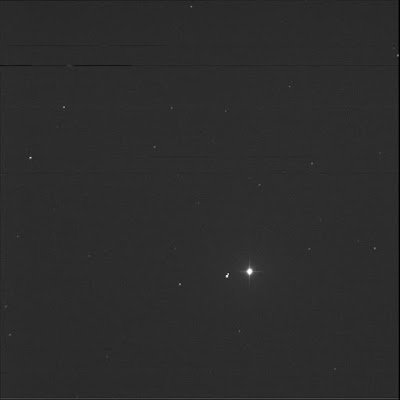I had had a request for ο (omicron) Eridani aka Keid, the multi-star system. The SMU observatory gathered good data, after aiming at GSC 05313 00997. Looks like a lovely triple!
Luminance only, ½ second subexposures, 20 stacked shots. FITS Liberator, Paint.NET. North is up; east is left.
The part of the reason for imaging this system (Struve 518) was because I wanted to double-check positions. When I last viewed this target on 19 Mar '18 from the backyard, I had noted the B star in a very different position than it was noted in SkyTools 3 Professional. ST3P shows B at a position angle of 65°. At the time I thought it approx. 60° different from that, counterclockwise in my SCT, therefore an increase in the PA, perhaps 125°. It is obvious in the image above that B (and C) are to the east-south-east. That's a PA of roughly 100°. Curiously, ST3P states in the Object Information box that the AB angle is 104° as of 2002. Here's an instance where the visual chart is very different than the OI data and it threw me off back in March.
Also, SkyTools notes another pair: Aa. With a PA of 97 and separation of 77.9. But it seems, early in 2018, I did not see this companion either.
The Washington Double Star database shows the Keid is a 5-star system with the following data:
| pair | first | last | PA1 | PA2 | sep1 | sep2 |
| A,BC | 1783 | 2016 | 108 | 102 | 89.2 | 83.7 |
| AC | 1987 | 2011 | 117 | 97 | 79.4 | 77.3 |
| AD | 1850 | 1998 | 197 | 38 | 128.3 | 481.4 |
| AE | 1850 | 1998 | 279 | 24 | 99.4 | 569.9 |
| BC | 1851 | 2017 | 160 | 331 | 3.0 | 8.3 |
| BD | 1922 | 1999 | 196 | 28 | 147.0 | 457.0 |
| BE | 1922 | 1999 | 356 | 16 | 279.5 | 563.7 |
SkyTools lists the A, B, and C stars. The D and E stars from the WDS are mag 12-13 stars well away. They are visible to the north-north-east in the image. I'm curious why the bright, closer star beyond BC is not included.
The BC, BD, and BE alternate measures support the main entries.
A plot, using the current or most recent positions, from my Excel mapper tool. Good correspondence to the image.
It looks like for the A-to-B data, there's been little movement. It seems the C is moving about B. SkyTools and other sources quote the B-C orbital period around 250 years.
But the D and E values are kinda crazy. I'll consider that this is not real motion but errors in the original observations.
The SkyTools Aa entry looks suspiciously like the WDS AC datum. I think therefore I should discard it.
By the way, Wikipedia says 40 Eri is a triple.
§
Wikipedia link: 40 Eridani.




No comments:
Post a Comment